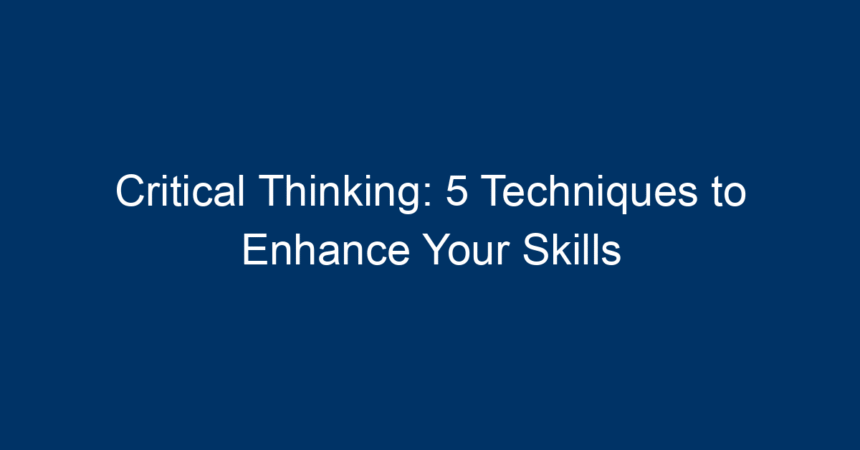In today’s fast-paced world, the ability to think critically is more essential than ever. We are bombarded with information from various sources, making it crucial to discern what is valuable and relevant. Whether you’re a student, a professional, or simply someone eager to make informed decisions, enhancing your critical thinking skills can empower you to navigate complexities and make sound judgments. This article explores five effective techniques to boost your critical thinking abilities, helping you become a more analytical and objective thinker.
Understanding Critical Thinking
Before delving into the techniques, let’s clarify what critical thinking involves. Critical thinking is the process of actively analyzing, synthesizing, and evaluating information gathered from observation, experience, reflection, reasoning, or communication. It requires complete engagement with the material at hand, prompting you to question assumptions and consider alternative perspectives.
The Importance of Critical Thinking
- Informed Decision-Making: Quality decisions stem from logical, constructive reasoning.
- Problem Solving: Critical thinking equips you to tackle complex challenges effectively.
- Enhanced Communication: Engaging critically with ideas promotes clearer articulation of thoughts.
- Increased Creativity: A critical thinker is also an innovator; analysis fosters original ideas.
Now that we understand the significance of critical thinking, let’s explore five powerful techniques to enhance these skills.
Technique 1: Ask Probing Questions
One of the simplest yet most effective ways to enhance critical thinking is to ask probing questions. This technique shifts your perspective and encourages deeper insights. Here’s how you can implement it:
How to Apply Probing Questions
- Why?: Always ask why something is the way it is. For example, when presented with a new idea, question its relevance and foundation.
- What if?: This encourages you to explore alternative scenarios, prompting innovative thinking.
- Who benefits?: Analyzing who stands to gain from certain information can expose biases and motivations.
Example
Imagine you are evaluating a business proposal. Instead of accepting it at face value, ask, "What evidence supports this?" or "What might be the drawbacks?" These questions deepen your understanding and uncover potential flaws in reasoning or data.
Technique 2: Engage in Reflective Thinking
Reflective thinking involves reviewing your own thoughts and reasoning processes. This technique encourages you to evaluate previous experiences critically and learn from them.
How to Engage in Reflective Thinking
- Journaling: Keep a critical thinking journal where you note down thoughts, advice, and questions.
- Self-Assessment: After completing a task, ask yourself: What went well? What could I improve? This results in a constructive feedback loop.
Example
At the end of each week, take time to reflect on your decisions. If you faced a challenging situation, write down the approaches you took and evaluate their effectiveness. This practice not only bolsters critical thinking but also promotes continuous personal growth.
Technique 3: Utilize the "Six Thinking Hats" Method
Developed by Edward de Bono, the Six Thinking Hats technique is a structured way to think about different aspects of an issue. By assigning specific ‘hats’ to various perspectives, you engage in a thorough exploration of complex problems.
Understanding the Six Hats
- White Hat: Focuses on data and information.
- Red Hat: Explores feelings and emotions.
- Black Hat: Considers potential pitfalls and difficulties.
- Yellow Hat: Looks at positives and benefits.
- Green Hat: Encourages creativity and new ideas.
- Blue Hat: Manages the thinking process and organization.
How to Apply
When faced with a decision, gather a group and assign each person a ‘hat’ to wear. This allows every aspect of the issue to be addressed systematically and promotes diverse viewpoints.
Example
If your team is brainstorming a new marketing strategy, have one person wear the Black Hat to voice criticisms, while another wears the Yellow Hat to highlight potential benefits. This multi-faceted approach sharpens your team’s critical thinking abilities by considering various angles.
Technique 4: Engage in Discussions and Debates
Constructive debates encourage you to articulate your thoughts, defend your viewpoints, and listen to opposing ideas. Engaging in thoughtful discussions with people who may hold different perspectives enriches your critical thinking skills.
How to Effectively Engage in Discussions
- Listen Actively: Show genuine interest in others’ opinions. It fosters a healthy exchange of ideas.
- Challenge Assumptions: Don’t shy away from questioning the status quo. Doing so opens avenues for new understanding.
- Stay Open-Minded: Be willing to revise your conclusions based on new evidence or compelling arguments.
Example
Join community groups or platforms dedicated to discourse. Engaging in discussions about current events or philosophical issues can sharpen your critical thinking as you articulate your stance and hone your reasoning abilities.
Technique 5: Embrace Continuous Learning
Critical thinking is a skill that thrives on knowledge. Continuous learning keeps your mind agile and adaptable, offing new perspectives and insights.
How to Foster Continuous Learning
- Read Widely: Explore various topics—science, art, philosophy—to broaden your understanding.
- Take Online Courses: Resources like Coursera or Udemy offer courses specifically designed to enhance critical thinking and analytical skills.
- Attend Workshops and Seminars: Local or virtual workshops can provide new strategies for developing critical thinking.
Example
For instance, if you work in healthcare, attending workshops on emerging medical technologies can provide a fresh perspective on patient care. It also prompts critical evaluation of how these technologies can affect practices and outcomes.
Conclusion: Taking Action to Enhance Your Critical Thinking Skills
Enhancing your critical thinking skills is not only beneficial; it’s essential for personal and professional growth. By implementing these five techniques—asking probing questions, engaging in reflective thinking, utilizing the Six Thinking Hats method, participating in discussions, and embracing continuous learning—you can develop a robust framework for analyzing information critically.
In a world awash with data, strengthening your critical thinking skills ensures that you can sift through the noise, make informed decisions, and approach problems with confidence. Start incorporating these techniques into your daily life today, and watch as your ability to think critically transforms your interactions and decisions.
By actively engaging with these techniques, you not only improve your own cognitive abilities but also inspire others around you to embrace critical thinking. After all, fostering an environment of thoughtful inquiry benefits everyone. So, what are you waiting for? Start thinking critically today!




